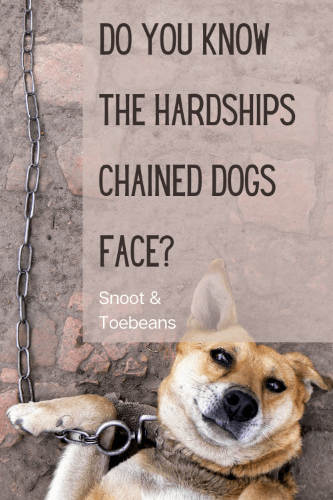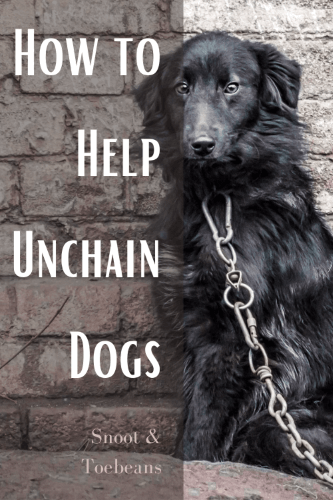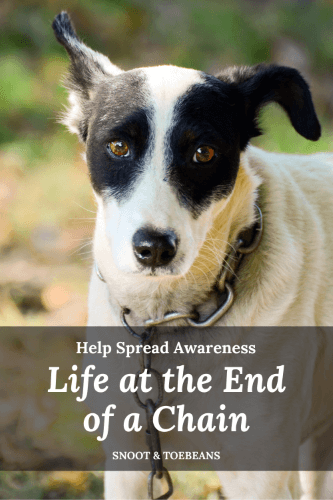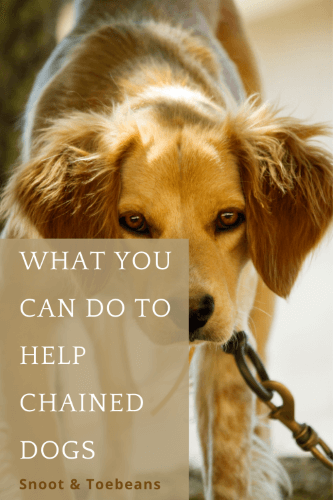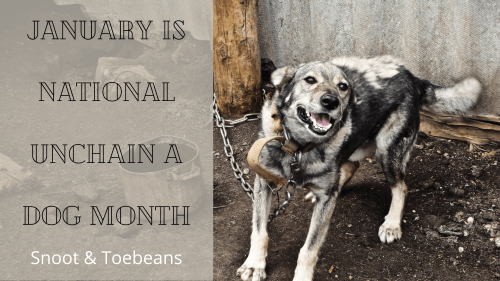Disclosure: My dog blog is supported by dog parents just like you. I only recommend products that I would use on my dogs. All opinions expressed here are my own. I sometimes earn a small affiliate commission, at no extra cost to you, when you click through the affiliate link and purchase something. You can read more about my affiliate policy here.
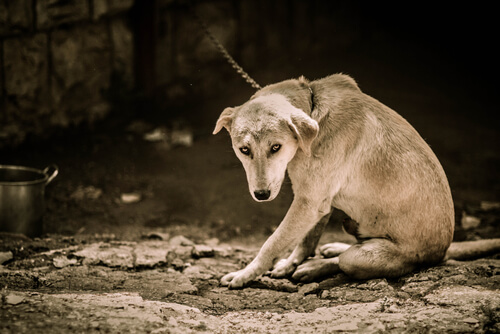
In the land of the free, not every living creature is free. Chaining dogs can be a form of imprisonment. January is known as National Unchain a Dog Month. Furthermore, this entire month is about spreading awareness to the hardship that dogs may face on a chain.
This “awareness” day was founded by People for the Ethical Treatment of Animals (PETA). PETA wants people to be aware that chaining dogs is detrimental to their physical and psychological health. However, this hardship is more from chaining dogs 24/7 or for very long periods of time.
Nevertheless, there are many cases where chaining dogs is argued as necessary. And, this argued necessity has its own set of tips that I will cover later in this post. However, the awareness that needs to be spread during this month is for the dogs continually chained.
Continually Chaining Dogs Causes Hardships
Most dogs continually on chains are in the backyard all alone. In other words, very seldom are they let off of that chain. They become easily ignored… “out of sight, out of mind.”
Dogs are social creatures! Plus, they are pack animals. They long for and need the interaction of their human family. So, it is understandable why chaining dogs alone for days, months, and years causes physical and mental suffering. Furthermore, it’s inhumane.
“Our experience in enforcing the Animal Welfare Act has led us to conclude that continuous confinement of dogs by a tether is inhumane. A tether significantly restricts a dog’s movement. A tether can also become tangled around or hooked on the dog’s shelter structure or other objects, further restricting the dog’s movement and potentially causing injury.”
U.S. Department of Agriculture (USDA), July 2, 1996, Federal Register
These dogs live their life at the end of a chain all day and night enduring unbelievable hardships. So, I’ve listed some of those to help spread awareness to the inhumanity of chaining dogs.
Inadequate Food, Water, Medical Care, and Physical Activity
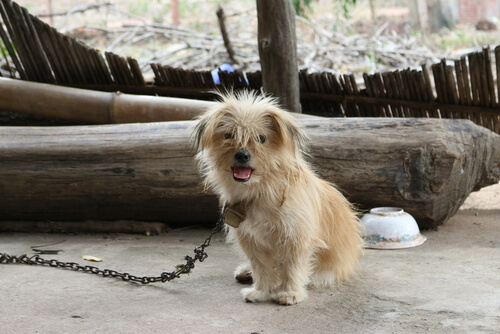
A lot of these dogs suffer from irregular feeding times and forgotten or turned over water bowls. Furthermore, their chains become entangled, preventing them from accessing food and water.
As a result, these poor dogs become starved, dehydrated, and ill. And, speaking of ill, they are rarely seen by a veterinarian. Therefore, they do not receive adequate medical care.
In addition, their range of motion is extremely limited, especially if their chain becomes entangled. Therefore, exercise, or physical activity is lacking.
Detrimental Weather Conditions
Most of these dogs suffer from weather extremities in both the summer and winter. To clarify, they are susceptible to either overheating or freezing to death. And, every year, many do die from these conditions.
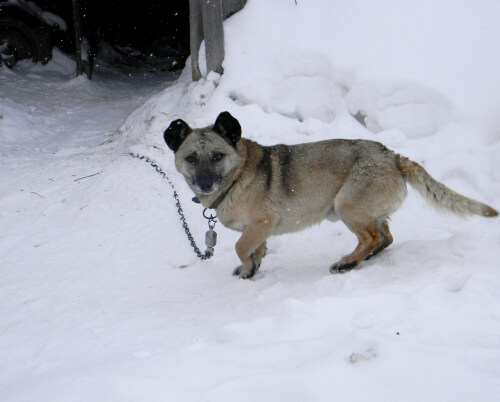
During the frigid winter months there is no warmth. Furthermore, many dogs on chains do not have an adequate shelter to protect them from rain or snow. As a result, they suffer from frostbite. In addition, they can suffer from dehydration because their water resource freezes.
During the sweltering summer months there is not a means to cool off. A doghouse might protect them from summer thunderstorms, but it doesn’t provide much relief from the heat. In other words, a doghouse traps hot air inside similar to how an oven does.
In addition, their water resource is hot and more than likely dirty. So, this can’t even relieve their parched throats.
Unclean Confined Area
A lot of these dogs suffer from a filthy living situation. For instance, they are in a very confined area due to their more than likely entangled chain. Therefore, their only choice is to urinate and defecate in the same area as they eat and sleep.
If that condition isn’t bad enough, add the fact that this area is hard-packed dirt rarely cleaned. In addition, this filthy condition causes exposure to disease-carrying insects including ticks, fleas, and mosquitos.
Severe Neck Injuries and Strangulation
Many of these dogs suffer from severe neck abrasions by often lunging or pulling against a chain. Plus, the chains and collars that encircle their necks become embedded from trying to escape their bondage.
Furthermore, chaining dogs has resulted in death from strangulation. For instance, a dog at the end of a chain may try to jump over a fence. However, this can happen even trying to jump over an object, such as a doghouse.
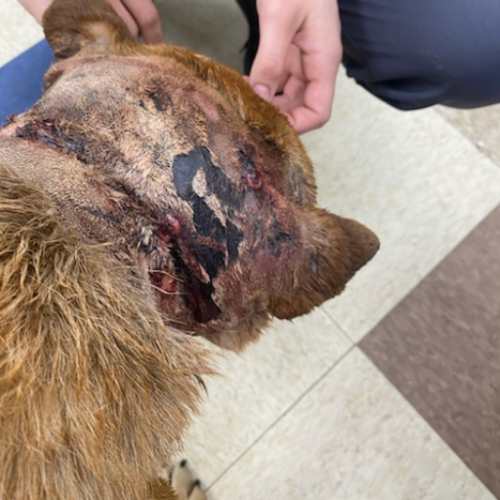
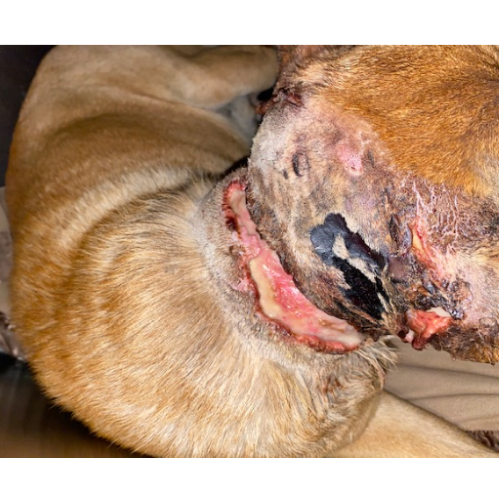
Lack of Affection and Socialization Causes Anxiety and Aggression
As a result of “out of sight, out of mind”, these dogs receive no affection or socialization. Therefore, the lack of these makes a chained dog more likely to bite than a socialized dog.
To clarify, these dogs have a “fight or flight” instinct when confronted with a perceived threat. As a result of their chains, they can’t flee. Therefore, they can injure children or others who happen to wander into their yard.
“Never tether or chain your dog, because this can contribute to aggressive behavior.”
American Veterinary Medical Association (AVMA)
Vulnerable to Cruelty
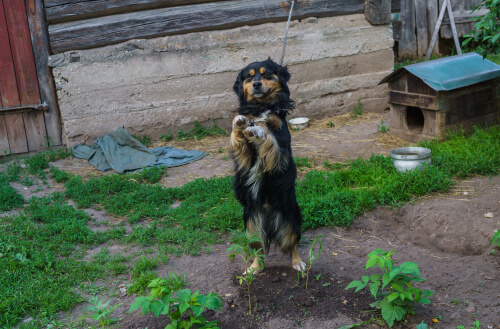
Many of these dogs suffer from wild animal attacks or other cruel humans. For example, they simply can’t escape from an aggressive wild animal or loose-roaming dog.
However, their vulnerability to cruel humans is the worst. Some of these defenseless creatures have been shot, poisoned, stoned and even set on fire.
Furthermore, they bark constantly out of frustration and loneliness. As a result, they turn into a public nuisance for annoyed neighbors.
Tips for Chaining Dogs as an Argued Necessity
As responsible parents, we restrain our dogs with a leash when going out for fresh air and exercise. We do this because it is our responsibility to not let our dogs run loose. And, this restraint is acceptable! However, it should only be for short periods at a time.
Likewise, it is also our responsibility to provide adequate attention and socialization for our dogs. Therefore, if chaining a dog is a necessity, then giving attention and socialization should be, too!
Here are some tips for chaining dogs as an argued necessity:
- Secure on a chain for only short periods of time
- Make sure the chain can’t become entangled
- Collars should be comfortable and properly fitted
- Absolutely no choke chains
- Keep indoors at night
- Take on regular walks
- Give attention through love and play
- Take for regular veterinarian visits
- Shelter from elements when outside
- Adequate space to move about and lie down comfortably
Our friends at Bark ATL have some great tips and precautions to take during the inclement winter weather.
Above all, chaining dogs is never acceptable during natural disasters such as floods, fires, tornadoes, hurricanes, or blizzards.
In Conclusion
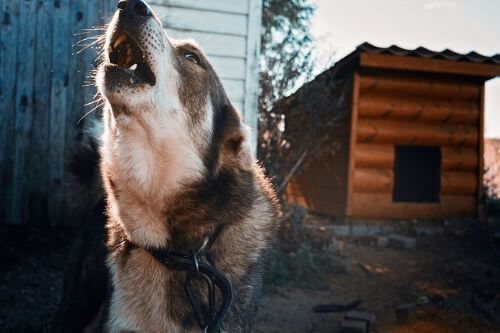
Continually chaining dogs is NOT okay! Therefore, I hope I have made you aware of the grave hardships continually chained dogs face. Furthermore, living life at the end of a chain with these hardships isn’t fair, nor is it humane.
In addition to spreading awareness, we can advocate for specific dogs in our neighborhoods. For instance, we can ask our local animal care and control agencies to visit the owners. Many times a situation can be improved through positive engagement.
You and I can be advocates for these dogs by spreading awareness during National Unchain a Dog month. But, really we can help any time.
Furthermore, we can volunteer for nonprofit organizations who reach out to these owners with information, resources and services. Plus, it is more beneficial to find positive, constructive ways to empower owners to unchain their dogs themselves.
Visit unchainyourdog.org or dogsdeservebetter.org for articles, statistics, photos, ordinance language, and other information about chaining dogs.
Do you have a success story with helping a chained dog? We would love to read about it in the comments below.
You might want to read these posts from our blog:
You can help spread awareness to the hardship that dogs may face on a chain by sharing this post. You can use one of the following images to pin on Pinterest.
